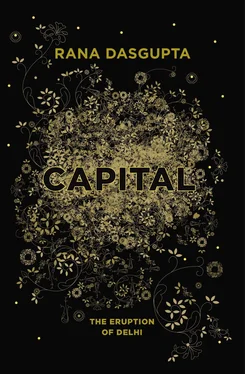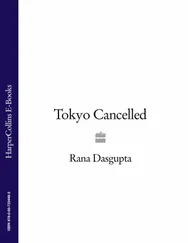Rana Dasgupta
Capital: The Eruption of Delhi
Oh, Moon of Alabama
We now must say goodbye
We’ve lost our good ol’ mama
And must have dollars, oh, you know why.
From The Rise & Fall of the City of Mahagonny (1930) by Kurt Weill and Bertolt Brecht


This book would not exist were it not for the generosity of several Delhi residents who agreed to discuss with me their lives, thoughts and experiences. These were often intimate discussions, which is why I have changed all names (except of public figures), and, in some cases, other identifying details. I request readers to respect the candour of these people — who sometimes took personal risks to speak to me — and not to attempt either to identify them or, where it is known, to reveal their identity.
In a place — and a world — where a person’s intellectual power is judged so much on the basis of their facility with the English language, I have chosen to make all characters in this book speak the same, standard, English so that their widely differing relationships to this language do not themselves become the issue. In reality, English was the second or third language for many of these individuals, and they did not speak it in this standard way; others did not speak English at all, and our interviews were carried out in Hindi. (In these latter cases I had the assistance of an interpreter.)
In Indian parlance, large amounts of money are measured in ‘lakhs’ and ‘crores’. A lakh is 100,000 rupees (Rs), or approximately US$2,000. A crore is 100 lakhs, or 10 million rupees: US$200,000. I have preserved these terms, which carry so much of the flavour of Indian financial discussion.
In certain places in the world, a ‘bungalow’ is a modest, even derisory, single-storey dwelling. In their colonial possessions, the British used this word to apply to the self-contained houses they built for their administrators, which were often, contrastingly, generous and grand. This is the usage that persists in modern Delhi — whose British-era centre is full of such houses — and in this book.
Capital is about the members of that rising, moneyed section of the Indian urban population who see themselves as the primary agents — and beneficiaries — of globalisation. It has become common to refer to these people as ‘the new Indian middle class’, and I, too, employ this phrase. But while their lifestyle has come to bear some resemblance to that of the ‘middle classes’ in Europe or America, the phrase sits uncomfortably with the Indian situation. At the time of writing, those Indians whose families earned more than Rs 500,000 [$10,000] per year represented less than 10 per cent of the population, which meant that ‘middle-class’ accoutrements and ideas belonged, in the Indian context, to the elite. Since the Indian economy was being restructured around the spending power of this emerging class, and since this entailed conflicts over land and resources which often punished the much greater number of the country’s rural poor — many of whom earned closer to $500 per year — it is important to retain this sense that the interests of the Indian middle classes were not lowly or innocent. The phrase ‘bourgeoisie’, in fact, which I also sometimes use, more accurately described their condition. At the same time, however, many of those who thought of themselves as ‘middle class’ did so because they identified with the hard-working, socially constructive overtones of the phrase, and because they wished to differentiate themselves from another, even smaller, elite — far richer and more powerful than they: moguls from the political and business classes, many of whom they regarded as selfish, reckless and fundamentally destructive to society. This distinction is also significant, which is why I generally follow the conventional terminology of ‘middle classes’ and ‘elites’ — even though the ‘middle classes’ are not really in the ‘middle’ at all.
March is the prettiest month, bringing flawless blooms to the dour frangipanis — which are placed artfully around the compound, in pleasing congruity with the posted security guards, who wave me on as I drive up to the house.
The day is done. Evening flowers have come into their own, and the air tides with scent. Ahead of me, under a velvet sky, the glass mansion glows like a giant yellow aquarium.
I park my car according to instructions, and walk out along the low-lit paths. At every corner a guard awaits, and directs me to the next. They pass me on, the guards, one to another, with walkie-talkie confirmations crackling back down the line. I arrive at the house.
The building is like two space stations, one glass and one stone, crossing over each other. One of them floats free of the earth, a shining bridge to nowhere, its underside glinting with landing beacons.
Everything is improbably pristine. The corners are straight and sharp. No gravel spills from the decorative channels that border the path.
The guards instruct me to walk through the house to the swimming pool at the back. They indicate a spot-lit passageway. The sliding doors are drawn half across, blocking one side of the entrance: I set off through the other, open side and — do I hear the guards’ warning cries before or after? — walk straight into a sheet of plate glass, so clean and so non-reflective that even though I have just staggered back from it, even though I have just bent double, clutching my crumpled nose, I still cannot tell it is there.
The guards are laughing. One of them runs to assist the idiot visitor. He advises me to enter the passage not through the glass but through the door — a normal door, nothing sliding about it. He demonstrates to me a how a door works so that I do not injure myself again.
I pass through the house. A hall sweeps away from me, done up like a designer hotel. Velvet lampshades in high-frequency colours hang from the high ceiling. Designer couches are clustered here and there around crystal tables. On the walls hang enormous canvasses painted with the kind of energetic soft porn you see on posters for DJ dance nights. Lounge music plays from speakers hidden throughout the building.
I come out on the other side of the house, where everything is lit by that secret, erotic blue that rises from private pools at night. I am led to a poolside seat. A glass is placed in front of me with a sealed bottle of water.
“Sir will be with you in a minute.”
• • •
In a city of euphemisms, this place is called a ‘farmhouse’.
Nothing is farmed here, of course. But when, in the 1970s, the Delhi elite began seizing swathes of land to the south of the city to build private estates, the entire belt was reserved, according to the regulations, for agriculture — and, with a pang of propriety that touched the names of things even if it could not touch the things themselves, they called their new mansions ‘farmhouses’. This was especially important since many of the first farmhouses were built by the very bureaucrats and politicians who had made the regulations, severely correct individuals for whom irregularities in the names of things were an offence to the dignity of their office.
In the decades since then, the farmhouses to the south of Delhi have not only increased in number, changed hands several times, and ultimately acquired the legitimacy that accrues to every land grab once enough time has passed. They have also come to epitomise the lives of the city’s rich and well-connected, whose astonishing parties, car collections, sculpture gardens and loping Australian wildlife would be inconceivable except in the context of such fantastic estates. In no other Indian metropolis does the urban elite bask in such pastoral tranquillity: this is an idiosyncrasy of the capital. It is striking in fact how Delhi’s rich, a quintessentially metropolitan set of people, who have made their money by tirelessly networking in the capital’s many clubs and corridors, eschew the urbane. They do not, as the rich do in Mumbai or New York, dream of apartments with sparkling views of the city from which their fortune derives. They are not drawn to that energy of streets, sidewalks and bustle which was so heroic a part of great nineteenth- and twentieth-century cities. No: the Delhi rich like to wake up looking at empty, manicured lawns stretching away to walls topped with barbed wire.
Читать дальше













